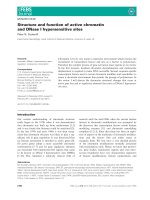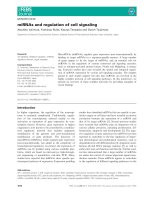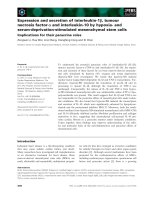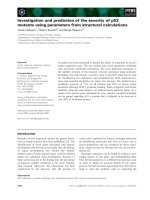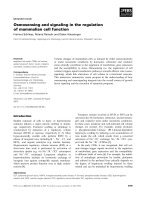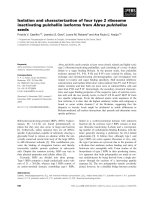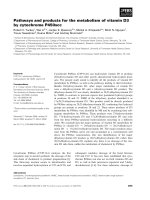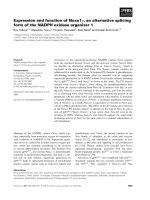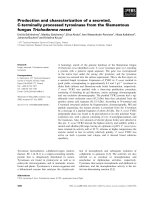Báo cáo khoa học: "Analysis and Synthesis of the Distribution of Consonants over Languages: A Complex Network Approach" pptx
Bạn đang xem bản rút gọn của tài liệu. Xem và tải ngay bản đầy đủ của tài liệu tại đây (357.3 KB, 8 trang )
Proceedings of the COLING/ACL 2006 Main Conference Poster Sessions, pages 128–135,
Sydney, July 2006.
c
2006 Association for Computational Linguistics
Analysis and Synthesis of the Distribution of Consonants over Languages:
A Complex Network Approach
Monojit Choudhury and Animesh Mukherjee and Anupam Basu and Niloy Ganguly
Department of Computer Science and Engineering,
Indian Institute of Technology Kharagpur
{monojit,animeshm,anupam,niloy}@cse.iitkgp.ernet.in
Abstract
Cross-linguistic similarities are reflected
by the speech sound systems of languages
all over the world. In this work we try
to model such similarities observed in the
consonant inventories, through a complex
bipartite network. We present a systematic
study of some of the appealing features of
these inventories with the help of the bi-
partite network. An important observation
is that the occurrence of consonants fol-
lows a two regime power law distribution.
We find that the consonant inventory size
distribution together with the principle of
preferential attachment are the main rea-
sons behind the emergence of such a two
regime behavior. In order to further sup-
port our explanation we present a synthe-
sis model for this network based on the
general theory of preferential attachment.
1 Introduction
Sound systems of the world’s languages show re-
markable regularities. Any arbitrary set of conso-
nants and vowels does not make up the sound sys-
tem of a particular language. Several lines of re-
search suggest that cross-linguistic similarities get
reflected in the consonant and vowel inventories
of the languages all over the world (Greenberg,
1966; Pinker, 1994; Ladefoged and Maddieson,
1996). Previously it has been argued that these
similarities are the results of certain general prin-
ciples like maximal perceptual contrast (Lindblom
and Maddieson, 1988), feature economy (Mar-
tinet, 1968; Boersma, 1998; Clements, 2004) and
robustness (Jakobson and Halle, 1956; Chomsky
and Halle, 1968). Maximal perceptual contrast
between the phonemes of a language is desir-
able for proper perception in a noisy environment.
In fact the organization of the vowel inventories
across languages has been satisfactorily explained
in terms of the single principle of maximal percep-
tual contrast (Jakobson, 1941; Wang, 1968).
There have been several attempts to reason
the observed patterns in consonant inventories
since 1930s (Trubetzkoy, 1969/1939; Lindblom
and Maddieson, 1988; Boersma, 1998; Flemming,
2002; Clements, 2004), but unlike the case of vow-
els, the structure of consonant inventories lacks a
complete and holistic explanation (de Boer, 2000).
Most of the works are confined to certain indi-
vidual principles (Abry, 2003; Hinskens and Wei-
jer, 2003) rather than formulating a general the-
ory describing the structural patterns and/or their
stability. Thus, the structure of the consonant in-
ventories continues to be a complex jigsaw puzzle,
though the parts and pieces are known.
In this work we attempt to represent the cross-
linguistic similarities that exist in the consonant
inventories of the world’s languages through a
bipartite network named PlaNet (the Phoneme
Language Network). PlaNet has two different sets
of nodes, one labeled by the languages while the
other labeled by the consonants. Edges run be-
tween these two sets depending on whether or not
a particular consonant occurs in a particular lan-
guage. This representation is motivated by similar
modeling of certain complex phenomena observed
in nature and society, such as,
• Movie-actor network, where movies and ac-
tors constitute the two partitions and an edge
between them signifies that a particular actor
acted in a particular movie (Ramasco et al.,
2004).
128
• Article-author network, where the edges de-
note which person has authored which arti-
cles (Newman, 2001b).
• Metabolic network of organisms, where the
corresponding partitions are chemical com-
pounds and metabolic reactions. Edges run
between partitions depending on whether a
particular compound is a substrate or result
of a reaction (Jeong et al., 2000).
Modeling of complex systems as networks has
proved to be a comprehensive and emerging way
of capturing the underlying generating mecha-
nism of such systems (for a review on complex
networks and their generation see (Albert and
Barab
´
asi, 2002; Newman, 2003)). There have
been some attempts as well to model the intri-
cacies of human languages through complex net-
works. Word networks based on synonymy (Yook
et al., 2001b), co-occurrence (Cancho et al., 2001),
and phonemic edit-distance (Vitevitch, 2005) are
examples of such attempts. The present work also
uses the concept of complex networks to develop
a platform for a holistic analysis as well as synthe-
sis of the distribution of the consonants across the
languages.
In the current work, with the help of PlaNet we
provide a systematic study of certain interesting
features of the consonant inventories. An impor-
tant property that we observe is the two regime
power law degree distribution
1
of the nodes la-
beled by the consonants. We try to explain this
property in the light of the size of the consonant
inventories coupled with the principle of preferen-
tial attachment (Barab
´
asi and Albert, 1999). Next
we present a simplified mathematical model ex-
plaining the emergence of the two regimes. In or-
der to support our analytical explanations, we also
provide a synthesis model for PlaNet.
The rest of the paper is organized into five sec-
tions. In section 2 we formally define PlaNet, out-
line its construction procedure and present some
studies on its degree distribution. We dedicate sec-
tion 3 to state and explain the inferences that can
be drawn from the degree distribution studies of
PlaNet. In section 4 we provide a simplified the-
oretical explanation of the analytical results ob-
1
Two regime power law distributions have also been
observed in syntactic networks of words (Cancho et al.,
2001), network of mathematics collaborators (Grossman et
al., 1995), and language diversity over countries (Gomes et
al., 1999).
Figure 1: Illustration of the nodes and edges of
PlaNet
tained. In section 5 we present a synthesis model
for PlaNet to hold up the inferences that we draw
in section 3. Finally we conclude in section 6 by
summarizing our contributions, pointing out some
of the implications of the current work and indi-
cating the possible future directions.
2 PlaNet: The Phoneme-Language
Network
We define the network of consonants and lan-
guages, PlaNet, as a bipartite graph represented as
G = V
L
, V
C
, E where V
L
is the set of nodes la-
beled by the languages and V
C
is the set of nodes
labeled by the consonants. E is the set of edges
that run between V
L
and V
C
. There is an edge e ∈
E between two nodes v
l
∈ V
L
and v
c
∈ V
C
if and
only if the consonant c occurs in the language l.
Figure 1 illustrates the nodes and edges of PlaNet.
2.1 Construction of PlaNet
Many typological studies (Lindblom and Mad-
dieson, 1988; Ladefoged and Maddieson, 1996;
Hinskens and Weijer, 2003) of segmental inven-
tories have been carried out in past on the UCLA
Phonological Segment Inventory Database (UP-
SID) (Maddieson, 1984). UPSID initially had 317
languages and was later extended to include 451
languages covering all the major language families
of the world. In this work we have used the older
version of UPSID comprising of 317 languages
and 541 consonants (henceforth UPSID
317
), for
constructing PlaNet. Consequently, there are 317
elements (nodes) in the set V
L
and 541 elements
129
(nodes) in the set V
C
. The number of elements
(edges) in the set E as computed from PlaNet is
7022. At this point it is important to mention that
in order to avoid any confusion in the construc-
tion of PlaNet we have appropriately filtered out
the anomalous and the ambiguous segments (Mad-
dieson, 1984) from it. We have completely ig-
nored the anomalous segments from the data set
(since the existence of such segments is doubtful),
and included the ambiguous ones as separate seg-
ments because there are no descriptive sources ex-
plaining how such ambiguities might be resolved.
A similar approach has also been described in Per-
icliev and Vald
´
es-P
´
erez (2002).
2.2 Degree Distribution of PlaNet
The degree of a node u, denoted by k
u
is defined as
the number of edges connected to u. The term de-
gree distribution is used to denote the way degrees
(k
u
) are distributed over the nodes (u). The de-
gree distribution studies find a lot of importance in
understanding the complex topology of any large
network, which is very difficult to visualize oth-
erwise. Since PlaNet is bipartite in nature it has
two degree distribution curves one corresponding
to the nodes in the set V
L
and the other corre-
sponding to the nodes in the set V
C
.
Degree distribution of the nodes in V
L
: Fig-
ure 2 shows the degree distribution of the nodes
in V
L
where the x-axis denotes the degree of each
node expressed as a fraction of the maximum de-
gree and the y-axis denotes the number of nodes
having a given degree expressed as a fraction of
the total number of nodes in V
L
.
It is evident from Figure 2 that the number of
consonants appearing in different languages fol-
low a β-distribution
2
(see (Bulmer, 1979) for ref-
erence). The figure shows an asymmetric right
skewed distribution with the values of α and β
equal to 7.06 and 47.64 (obtained using maximum
likelihood estimation method) respectively. The
asymmetry points to the fact that languages usu-
ally tend to have smaller consonant inventory size,
2
A random variable is said to have a β-distribution with
parameters α > 0 and β > 0 if and only if its probability mass
function is given by
f(x) =
Γ(α + β)
Γ(α)Γ(β)
x
α−1
(1 − x)
β−1
for 0 < x < 1 and f (x) = 0 otherwise. Γ(·) is the Euler’s
gamma function.
Figure 2: Degree distribution of PlaNet for the set
V
L
. The figure in the inner box is a magnified
version of a portion of the original figure.
the best value being somewhere between 10 and
30. The distribution peaks roughly at 21 indicating
that majority of the languages in UPSID
317
have a
consonant inventory size of around 21 consonants.
Degree distribution of the nodes in V
C
: Fig-
ure 3 illustrates two different types of degree dis-
tribution plots for the nodes in V
C
; Figure 3(a)
corresponding to the rank, i.e., the sorted order of
degrees, (x-axis) versus degree (y-axis) and Fig-
ure 3(b) corresponding to the degree (k) (x-axis)
versus P
k
(y-axis) where P
k
is the fraction of
nodes having degree greater than or equal to k.
Figure 3 clearly shows that both the curves have
two distinct regimes and the distribution is scale-
free. Regime 1 in Figure 3(a) consists of 21 con-
sonants which have a very high frequency (i.e.,
the degree k) of occurrence. Regime 2 of Fig-
ure 3(b) also correspond to these 21 consonants.
On the other hand Regime 2 of Figure 3(a) as well
as Regime 1 of Figure 3(b) comprises of the rest
of the consonants. The point marked as x in both
the figures indicates the breakpoint. Each of the
regime in both Figure 3(a) and (b) exhibit a power
law of the form
y = Ax
−α
In Figure 3(a) y represents the degree k of a node
corresponding to its rank x whereas in Figure 3(b)
y corresponds to P
k
and x, the degree k. The val-
ues of the parameters A and α, for Regime 1 and
Regime 2 in both the figures, as computed by the
least square error method, are shown in Table 1.
130
Regime Figure 3(a) Figure 3(b)
Regime 1 A = 368.70 α = 0.4 A = 1.040 α = 0.71
Regime 2 A = 12456.5 α = 1.54 A = 2326.2 α = 2.36
Table 1: The values of the parameters A and α
Figure 3: Degree distribution of PlaNet for the set
V
C
in a log-log scale
It becomes necessary to mention here that such
power law distributions, known variously as Zipf’s
law (Zipf, 1949), are also observed in an extra-
ordinarily diverse range of phenomena including
the frequency of the use of words in human lan-
guage (Zipf, 1949), the number of papers scien-
tists write (Lotka, 1926), the number of hits on
web pages (Adamic and Huberman, 2000) and so
on. Thus our inferences, detailed out in the next
section, mainly centers around this power law be-
havior.
3 Inferences Drawn from the Analysis of
PlaNet
In most of the networked systems like the society,
the Internet, the World Wide Web, and many oth-
ers, power law degree distribution emerges for the
phenomenon of preferential attachment, i.e., when
“the rich get richer” (Simon, 1955). With refer-
ence to PlaNet this preferential attachment can be
interpreted as the tendency of a language to choose
a consonant that has been already chosen by a
large number of other languages. We posit that it is
this preferential property of languages that results
in the power law degree distributions observed in
Figure 3(a) and (b).
Nevertheless there is one question that still re-
mains unanswered. Whereas the power law distri-
bution is well understood, the reason for the two
distinct regimes (with a sharp break) still remains
unexplored. We hypothesize that,
Hypothesis The typical distribution of the conso-
nant inventory size over languages coupled with
the principle of preferential attachment enforces
the two distinct regimes to appear in the power
law curves.
As the average consonant inventory size in
UPSID
317
is 21, so following the principle of
preferential attachment, on an average, the first
21 most frequent consonants are much more pre-
ferred than the rest. Consequently, the nature of
the frequency distribution for the highly frequent
consonants is different from the less frequent ones,
and hence there is a transition from Regime 1 to
Regime 2 in the Figure 3(a) and (b).
Support Experiment: In order to establish that
the consonant inventory size plays an important
role in giving rise to the two regimes discussed
above we present a support experiment in which
we try to observe whether the breakpoint x shifts
as we shift the average consonant inventory size.
Experiment: In order to shift the average con-
sonant inventory size from 21 to 25, 30 and 38
we neglected the contribution of the languages
with consonant inventory size less than n where
n is 15, 20 and 25 respectively and subsequently
recorded the degree distributions obtained each
time. We did not carry out our experiments for
average consonant inventory size more than 38 be-
cause the number of such languages are very rare
in UPSID
317
.
Observations: Figure 4 shows the effect of this
shifting of the average consonant inventory size on
the rank versus degree distribution curves. Table 2
presents the results observed from these curves
with the left column indicating the average inven-
tory size and the right column the breakpoint x.
131
Figure 4: Degree distributions at different average
consonant inventory sizes
Avg. consonant inv. size
Transition
25 25
30 30
38 37
Table 2: The transition points for different average
consonant inventory size
The table clearly indicates that the transition oc-
curs at values corresponding to the average conso-
nant inventory size in each of the three cases.
Inferences: It is quite evident from our observa-
tions that the breakpoint x has a strong correlation
with the average consonant inventory size, which
therefore plays a key role in the emergence of the
two regime degree distribution curves.
In the next section we provide a simplistic math-
ematical model for explaining the two regime
power law with a breakpoint corresponding to the
average consonant inventory size.
4 Theoretical Explanation for the Two
Regimes
Let us assume that the inventory of all the lan-
guages comprises of 21 consonants. We further as-
sume that the consonants are arranged in their hier-
archy of preference. A language traverses the hier-
archy of consonants and at every step decides with
a probability p to choose the current consonant. It
stops as soon as it has chosen all the 21 conso-
nants. Since languages must traverse through the
first 21 consonants regardless of whether the pre-
vious consonants are chosen or not, the probability
of choosing any one of these 21 consonants must
be p. But the case is different for the 22
nd
conso-
nant, which is chosen by a language if it has pre-
viously chosen zero, one, two, or at most 20, but
not all of the first 21 consonants. Therefore, the
probability of the 22
nd
consonant being chosen is,
P (22) = p
20
i=0
21
i
p
i
(1 − p)
21−i
where
21
i
p
i
(1 − p)
21−i
denotes the probability of choosing i consonants
from the first 21. In general the probability of
choosing the n+1
th
consonant from the hierarchy
is given by,
P (n + 1) = p
20
i=0
n
i
p
i
(1 − p)
n−i
Figure 5 shows the plot of the function P (n) for
various values of p which are 0.99, 0.95, 0.9, 0.85,
0.75 and 0.7 respectively in log-log scale. All the
curves, for different values of p, have a nature sim-
ilar to that of the degree distribution plot we ob-
tained for PlaNet. This is indicative of the fact that
languages choose consonants from the hierarchy
with a probability function comparable to P (n).
Owing to the simplified assumption that all
the languages have only 21 consonants, the first
regime is a straight line; however we believe a
more rigorous mathematical model can be built
taking into consideration the β-distribution rather
than just the mean value of the inventory size that
can explain the negative slope of the first regime.
We look forward to do the same as a part of our fu-
ture work. Rather, here we try to investigate the ef-
fect of the exact distribution of the language inven-
tory size on the nature of the degree distribution of
the consonants through a synthetic approach based
on the principle of preferential attachment, which
is described in the subsequent section.
5 The Synthesis Model based on
Preferential Attachment
Albert and Barab
´
asi (1999) observed that a com-
mon property of many large networks is that the
vertex connectivities follow a scale-free power
law distribution. They remarked that two generic
mechanisms can be considered to be the cause
of this observation: (i) networks expand contin-
uously by the addition of new vertices, and (ii)
new vertices attach preferentially to sites (vertices)
that are already well connected. They found that
132
Figure 5: Plot of the function P (n) in log-log
scale
a model based on these two ingredients repro-
duces the observed stationary scale-free distrib-
utions, which in turn indicates that the develop-
ment of large networks is governed by robust self-
organizing phenomena that go beyond the particu-
lars of the individual systems.
Inspired by their work and the empirical as well
as the mathematical analysis presented above, we
propose a preferential attachment model for syn-
thesizing PlaNet (PlaNet
syn
henceforth) in which
the degree distribution of the nodes in V
L
is
known. Hence V
L
={L
1
, L
2
, . . ., L
317
} have
degrees (consonant inventory size) {k
1
, k
2
, . . .,
k
317
} respectively. We assume that the nodes in
the set V
C
are unlabeled. At each time step, a
node L
j
(j = 1 to 317) from V
L
tries to attach itself
with a new node i ∈ V
C
to which it is not already
connected. The probability P r(i) with which the
node L
j
gets attached to i depends on the current
degree of i and is given by
P r(i) =
k
i
+
i
∈V
j
(k
i
+ )
where k
i
is the current degree of the node i, V
j
is the set of nodes in V
C
to which L
j
is not al-
ready connected and is the smoothing parameter
which is used to reduce bias and favor at least a
few attachments with nodes in V
j
that do not have
a high P r(i). The above process is repeated un-
til all L
j
∈ V
L
get connected to exactly k
j
nodes
in V
C
. The entire idea is summarized in Algo-
rithm 1. Figure 6 shows a partial step of the syn-
thesis process illustrated in Algorithm 1.
Simulation Results: Simulations reveal that for
PlaNet
syn
the degree distribution of the nodes be-
longing to V
C
fit well with the analytical results
we obtained earlier in section 2. Good fits emerge
repeat
for j = 1 to 317 do
if there is a node L
j
∈ V
L
with at least
one or more consonants to be chosen
from V
C
then
Compute V
j
= V
C
-V (L
j
), where
V (L
j
) is the set of nodes in V
C
to
which L
j
is already connected;
end
for each node i ∈ V
j
do
P r(i) =
k
i
+
i
∈V
j
(k
i
+ )
where k
i
is the current degree of
the node i and is the model
parameter. P r(i) is the
probability of connecting L
j
to i.
end
Connect L
j
to a node i ∈ V
j
following the distribution P r(i);
end
until all languages complete their inventory
quota ;
Algorithm 1: Algorithm for synthesis of
PlaNet based on preferential attachment
Figure 6: A partial step of the synthesis process.
When the language L
4
has to connect itself with
one of the nodes in the set V
C
it does so with the
one having the highest degree (=3) rather than with
others in order to achieve preferential attachment
which is the working principle of our algorithm
for the range 0.06 ≤ ≤ 0.08 with the best being
at = 0.0701. Figure 7 shows the degree k versus
133
Figure 7: Degree distribution of the nodes in
V
C
for both PlaNet
syn
, PlaNet, and when the
model incorporates no preferential attachment; for
PlaNet
syn
, = 0.0701 and the results are averaged
over 100 simulation runs
P
k
plots for = 0.0701 averaged over 100 simula-
tion runs.
The mean error
3
between the degree distribu-
tion plots of PlaNet and PlaNet
syn
is 0.03 which
intuitively signifies that on an average the varia-
tion in the two curves is 3%. On the contrary, if
there were no preferential attachment incorporated
in the model (i.e., all connections were equiprob-
able) then the mean error would have been 0.35
(35% variation on an average).
6 Conclusions, Discussion and Future
Work
In this paper, we have analyzed and synthesized
the consonant inventories of the world’s languages
in terms of a complex network. We dedicated the
preceding sections essentially to,
• Represent the consonant inventories through
a bipartite network called PlaNet,
• Provide a systematic study of certain impor-
tant properties of the consonant inventories
with the help of PlaNet,
• Propose analytical explanations for the two
regime power law curves (obtained from
PlaNet) on the basis of the distribution of the
consonant inventory size over languages to-
gether with the principle of preferential at-
tachment,
3
Mean error is defined as the average difference between
the ordinate pairs where the abscissas are equal.
• Provide a simplified mathematical model to
support our analytical explanations, and
• Develop a synthesis model for PlaNet based
on preferential attachment where the conso-
nant inventory size distribution is known a
priori.
We believe that the general explanation pro-
vided here for the two regime power law is a fun-
damental result, and can have a far reaching im-
pact, because two regime behavior is observed in
many other networked systems.
Until now we have been mainly dealing with the
computational aspects of the distribution of conso-
nants over the languages rather than exploring the
real world dynamics that gives rise to such a distri-
bution. An issue that draws immediate attention is
that how preferential attachment, which is a gen-
eral phenomenon associated with network evolu-
tion, can play a prime role in shaping the conso-
nant inventories of the world’s languages. The an-
swer perhaps is hidden in the fact that language is
an evolving system and its present structure is de-
termined by its past evolutionary history. Indeed
an explanation based on this evolutionary model,
with an initial disparity in the distribution of con-
sonants over languages, can be intuitively verified
as follows – let there be a language community
of N speakers communicating among themselves
by means of only two consonants say /k/ and /g/.
If we assume that every speaker has l descendants
and language inventories are transmitted with high
fidelity, then after i generations it is expected that
the community will consist of ml
i
/k/ speakers and
nl
i
/g/ speakers. Now if m > n and l > 1, then for
sufficiently large i, ml
i
nl
i
. Stated differently,
the /k/ speakers by far outnumbers the /g/ speak-
ers even if initially the number of /k/ speakers is
only slightly higher than that of the /g/ speakers.
This phenomenon is similar to that of preferen-
tial attachment where language communities get
attached to, i.e., select, consonants that are already
highly preferred. Nevertheless, it remains to be
seen where from such an initial disparity in the dis-
tribution of the consonants over languages might
have originated.
In this paper, we mainly dealt with the occur-
rence principles of the consonants in the invento-
ries of the world’s languages. The work can be fur-
ther extended to identify the co-occurrence likeli-
hood of the consonants in the language inventories
134
and subsequently identify the groups or commu-
nities within them. Information about such com-
munities can then help in providing an improved
insight about the organizing principles of the con-
sonant inventories.
References
C. Abry. 2003. [b]-[d]-[g] as a universal triangle as
acoustically optimal as [i]-[a]-[u]. 15th Int. Congr.
Phonetics Sciences ICPhS, 727–730.
L. A. Adamic and B. A. Huberman. 2000. The na-
ture of markets in the World Wide Web. Quarterly
Journal of Electronic Commerce 1, 512.
R. Albert and A L. Barab
´
asi. 2002. Statistical me-
chanics of complex networks. Reviews of Modern
Physics 74, 47–97.
A L. Barab
´
asi and R. Albert. 1999. Emergence of
scaling in random networks. Science 286, 509-512.
Bart de Boer. 2000. Self-Organisation in Vowel Sys-
tems. Journal of Phonetics, Elsevier.
P. Boersma. 1998. Functional Phonology. (Doctoral
thesis, University of Amsterdam), The Hague: Hol-
land Academic Graphics.
M. G. Bulmer. 1979. Principles of Statistics, Mathe-
matics.
Ferrer i Cancho and R. V. Sol
´
e. 2001. Santa Fe work-
ing paper 01-03-016.
N. Chomsky and M. Halle. 1968. The Sound Pattern
of English, New York: Harper and Row.
N. Clements. 2004. Features and Sound Inventories.
Symposium on Phonological Theory: Representa-
tions and Architecture, CUNY.
E. Flemming. 2002. Auditory Representations in
Phonology, New York and London: Routledge.
M. A. F. Gomes, G. L. Vasconcelos, I. J. Tsang, and I.
R. Tsang. 1999. Scaling relations for diversity of
languages. Physica A, 271, 489.
J. H. Greenberg. 1966. Language Universals with Spe-
cial Reference to Feature Hierarchies, The Hague
Mouton.
J. W. Grossman and P. D. F. Ion. 1995. On a portion
of the well-known collaboration graph. Congressus
Numerantium, 108, 129-131.
F. Hinskens and J. Weijer. 2003. Patterns of segmen-
tal modification in consonant inventories: a cross-
linguistic study. Linguistics.
R. Jakobson. 1941. Kindersprache, Aphasie und allge-
meine Lautgesetze, Uppsala, Reprinted in Selected
Writings I. Mouton, The Hague, 1962, pages 328-
401.
H. Jeong, B. Tombor, R. Albert, Z. N. Oltvai, and A.
L. Barab
´
asi. 2000. The large-scale organization of
metabolic networks. Nature, 406:651-654.
R. Jakobson and M. Halle. 1956. Fundamentals of
Language, The Hague: Mouton and Co.
P. Ladefoged and I. Maddieson. 1996. Sounds of the
Worlds Languages, Oxford: Blackwell.
B. Lindblom and I. Maddieson. 1988. Phonetic Uni-
versals in Consonant Systems. In L.M. Hyman and
C.N. Li, eds., Language, Speech, and Mind, Rout-
ledge, London, 62–78.
A. J. Lotka. 1926. The frequency distribution of scien-
tific production. J. Wash. Acad. Sci. 16, 317-323.
I. Maddieson. 1984. Patterns of Sounds, Cambridge
University Press, Cambridge.
A. Martinet. 1968. Phonetics and linguistic evolu-
tion. In Bertil Malmberg (ed.), Manual of phonetics,
revised and extended edition, Amsterdam: North-
Holland Publishing Co. 464–487.
M. E. J. Newman. 2001b. Scientific collaboration net-
works. I and II. Phys. Rev., E 64.
M. E. J. Newman. 2003. The structure and function of
complex networks. SIAM Review 45, 167–256.
V. Pericliev, R. E. Vald
´
es-P
´
erez. 2002. Differentiating
451 languages in terms of their segment inventories.
Studia Linguistica, Blackwell Publishing.
S. Pinker. 1994. The Language Instinct, New York:
Morrowo.
Jos
´
e J. Ramasco, S. N. Dorogovtsev, and Romualdo
Pastor-Satorras. 2004. Self-organization of collabo-
ration networks. Physical Review E, 70, 036106.
H. A. Simon. 1955. On a class of skew distribution
functions. Biometrika 42, 425-440.
N. Trubetzkoy. 1969. Principles of phonology.
(English translation of Grundz
¨
uge der Phonologie,
1939), Berkeley: University of California Press.
M. S. Vitevitch. 2005. Phonological neighbors in a
small world: What can graph theory tell us about
word learning? Spring 2005 Talk Series on Networks
and Complex Systems, Indiana University, Bloom-
ington.
William S Y. Wang. 1968. The basis of speech,
Project on Linguistic Analysis Reports, University
of California at Berkeley. Reprinted in The Learning
of Language, ed. by C. E. Reed, 1971.
S. Yook, H. Jeong and A L. Barab
´
asi. 2001b. preprint.
G. K. Zipf. 1949. Human Behaviour and the Principle
of Least Effort, Addison-Wesley, Reading, MA.
135
